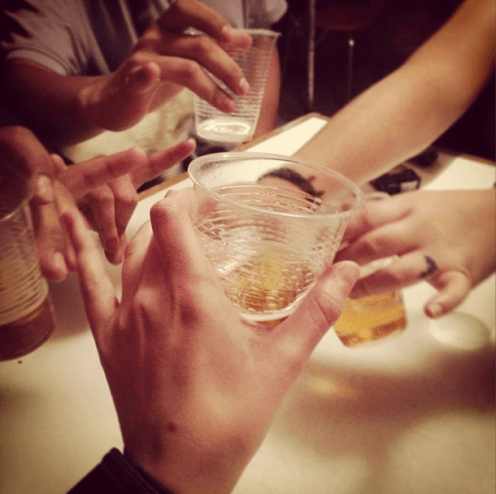
Neighborhood children celebrate Chile’s victory. Photo by Nell Haynes
The very first night I spent in my fieldsite in Northern Chile, the national team qualified for the World Cup. I had no TV, no radio, and internet only through my smartphone. But I knew every time the team scored. Horns honked, dogs barked, whistles cut through the evening air, a dull roar of shouts bouncing off one another between the small homes, and six floor apartment buildings hung around the city like the fog that rolls in every afternoon from the Pacific Ocean. When the opposing team scored, you could hear the low rumble of grumbling viewers. By the game’s end, the horns were honking again, fireworks were being set off, and I ventured to my balcony to see people waving large flags in the street.
After nine months in this working class city of 100,000 people, football is back, and it is everywhere. Though advertising in general is limited, people find individual ways to visibly express their excitement about World Cup. The single bar in the city has no signs outside or inside advertising that they will be open for games. Restaurants have no specials. This is possibly because people tend to watch at home with friends and family, grilling meat, and drinking beer, rather than watch in in a more public place. Or perhaps people feel inclined to watch from home because there is no incentive to watch in a public place. Either way, the result is clear. When I watched one afternoon game at the bar, I was one of only 5 patrons (all the others being 20-30 something men who seemed to know the bartender on duty). In fact, the family and friends joining together in each private home usually outnumbered those gathered in the bar.

A small crowd watches Chile vs. Netherlands in the local bar. Photo by Jair Correa.
The few instances of businesses advertising World Cup specials were limited to interntional companies. The hardware store (owned by US company Home Depot), and one supermarket (owned by Walmart) had special giveaways advertised, and of course the Coca Cola and Becker beer cans on sale throughout the country are decorated with football themed designs. But on a local level nothing commercialized about the World Cup. Instead, people have individually created visible practices associated with supporting their national team—wearing red football jerseys, setting off fireworks, and posting a great deal on social networking sites. These posts began about a week before the World Cup began, in anticipation.

A World Cup themed display in Sodimac Homecenter. Photo by Nell Haynes
Many of the Facebook posts were typically Chilean in style, in that they were humorous memes. Some compared the team’s coach, Jorge Sampaoli, who is bald, to bald reggaetón singer Pitbull. Others, in anticipation of a match against the Australian team, featured pictures of kangaroos in compromising positions. Others posted sarcastic cartoons about the blindness with which Chileans follow football, or “Survival Guides” for those uninterested in the games. Politically involved young people often posted links to articles about the protests in Brazil, often followed by an image supporting the Chilean team, and commenting on their sense of feeling torn between the game they love and the capitalist exploitations behind the event. “Vamos Chile…..a pesar que el trasfondo del mundial es una mierda no pueden negar que el futbol es hermoso sobretodo cuando gana chile” [Let’s go Chile…..it’s a shame that the transformation of the World Cup is shitty, but they can’t negate that football is beautiful and above all when chile wins”

A popular meme circulating before and during the Chile vs. Australia match.
On the day of the game, posts turned more personal. Young men and middle-aged mothers alike post on Facebook invitations to friends to watch the game in their homes, often enticing them with photos of beer or food accompanied by a Chilean flag or football. Local businesses such as Chinese restaurants suggest customers should “put their orders in now to go along with The Red” (the nickname for the national team).
The experience of watching the games was captured in photos posted on Facebook and Instagram. These usually consist of people wearing red football jerseys, red, white, and blue wigs, hats that look like footballs, and other variations on festive attire, while standing next to a large television displaying a match. Others display the meats being grilled while watching the game. Even those stuck at work during games. Posted selfies at their desk while draped in the national flag. The large percentage of men working in mining operations several hours outside of the city were not left out. A few hours later, after they’ve finished their twelve hour shift, workers in the nearby copper mines post their cell phone videos of hundreds of their coworkers erupting as they watch a goal being scored from the company dining hall.

An Instagram photo shared during the Chile vs. Spain game.
But more telling than these orchestrated photos and videos were the immediate reactions to the game that were posted in simple messages on Facebook. When there was something to cheer about, my Facebook feed instantly filled with simple statements of “conchetumare” (a somewhat all-purpose expletive), “weon!” (somewhat equivalent to ‘dude’), “vamos chile mierda” [let’s go chile. shit!], and of course, “goooollllll” after every score.
After the games, Instagram and Facebook again filled with photos of people celebrating in the streets. Huge crowds gathered in plazas to set off fireworks, sing fight songs, and generally continue the party. People posted videos of the national hymn being sung at the start of the game. These were not just young people, but grandparents and mothers carrying young children. Of course, the posts stopped about two hours after the game ended, but I could still hear the singing and fireworks through my closed window late into the night.
And then, the next day, in further, but subdued celebration, memes reappeared teasing opponents who lost, or chastising referees blamed for a Chilean loss. After defeating current world champion, Spain, a photo of an airplane bearing the Spanish flag, with “gentlemen, start your engines” was shared by many people.
Overall, on non-game days, about 20% of posts are related to the world cup. On game days, this rises slowly until they peak during the actual game the make up more than 60% of posts from the 90 people I follow on Facebook. Similarly, among Instagram users from my fieldsite, about 80% of photos posted during game time have something to do with the game. Clearly, for many people, life stopped in order to watch the game. Yet, in order to actively participate in a community of fans, social networking provided an outlet for humor, pride, predictions, and even gut reactions to plays. This may have something to do with the fact that people are watching in small groups in private spaces, rather than large numbers gathering in the local bar. While family members got up to dance and toot horns after each goal scored when I watched from friends’ homes, they seemed to want a more collective experience. This desire was summed up by my friend’s uncle, who after Chile’s win over Spain quickly declared, “Let’s all go outside and see what’s going on in the streets. If there’s a party happening we need to be a part of it.”

A mashup of photos of people literally partying in the street after the Chilean team beat Spain, posted on both Instagram and Facebook.
It is also worth noting that the number of posts on either social media site that reference support for a team other than Chile is almost non-existent. There is a somewhat large population of Colombian immigrants in the fieldsite, and thus, the Colombian team has had a few posts in it’s support. By overwhelmingly, the posts reference the team of the poster’s home nation. The World Cup is not about the world, but about Chile’s place in it, and Facebook, rather than acting as a window to a “global civil society” (Tomlinson and Young 2006:1) rather functions much as Anderson described early national newspapers as foundational to a sense of community as a nation. In fact the simultaneity he described (1983:37) has gone into warp speed as people have moved from reading the same daily news items, to being able to immediately comment on an acquaintance’s “conchatumadre” just seconds after a Chilean player scores. This Saturday, Chile will battle home team Brazil in the second round of the tournament, and might be eliminated. If that happens it will be interesting to see if excitement and Facebook posts continue, as people in my fieldsite cheer on other South American teams, or if the exit of the Chilean team will mean an absence of attention to the World Cup both in media consumption, and social media curation. Then again, maybe predictions will be right and we’ll never get a chance to know, because Chile will win it all!

A widely shared image of how Chile could pass through the rounds to win the World Cup.
References
Anderson, Benedict. Imagined Communities. London: Verso, 1983.
Tomlinson, Alan, and Christopher Young, eds. National identity and global sports events: Culture, politics, and spectacle in the Olympics and the football World Cup. SUNY Press, 2006.
THE WORLD CUP ON SOCIAL MEDIA WORLDWIDE
This article is part of a special series of blog posts profiling how social media is affecting how ordinary people from communities across the planet experience the 2014 World Cup.
Filed under Anthropology, Business, Chile, Comparison, Culture, Polymedia
Tags: anthropology, Facebook, family, fieldwork, Friends, Instagram, mobile phones, polymedia, social networking
3 Comments »

 Close
Close


















